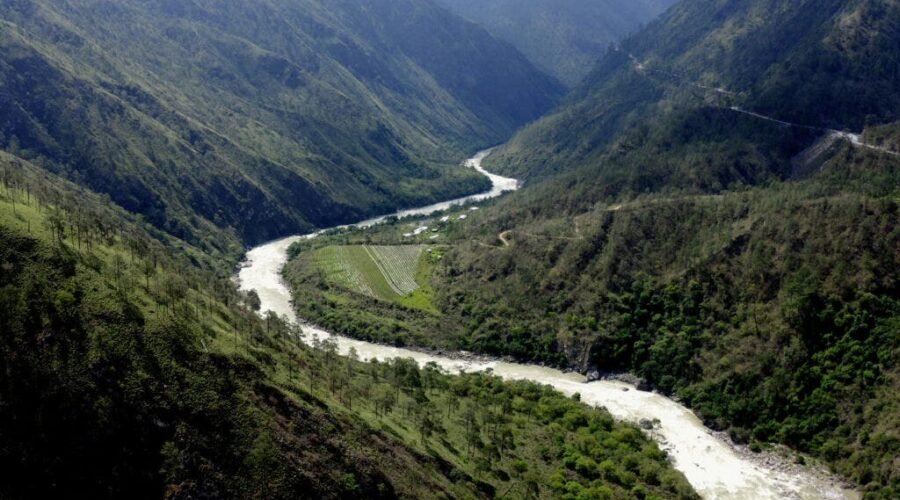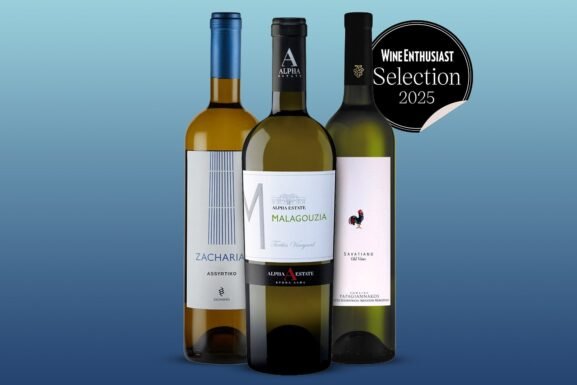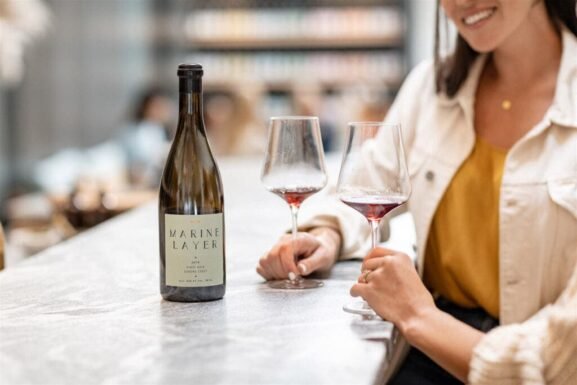Why Bhutan’s First-Ever Domestic Wine Is Such a Big Deal
A wine that nobody has tasted from a country that had never produced wine before sold for $18,750 this April in a historic silent auction at Bonhams. To put that into perspective, the vintage fetched the same price as a six-liter bottle of Pétrus 1986, a legendary Bordeaux.
“It’s mythological,” says Amayès Aouli, global head of wine and spirits at Bonhams, of the Bhutanese upstart. “It’s a wine you taste with your head and your heart.”
The wine in question? Ser Kem, the first-ever vintage from Bhutan—a country better known for its gravity-defying Buddhist temples, elusive snow leopards and cloud-piercing mountains than its fine vintages.
But now, this mist-shrouded sliver of land, home to nearly 800,000 people and wedged between India and China, is among the world’s newest wine producers. It’s especially exciting because the nation has no wine-producing history: Despite Portuguese Jesuits passing through in the 1600s, the Kingdom of Bhutan was never colonized, and Vitis vinifera were never part of its natural ecosystem. (However, ara—a moonshine-like drink from rice, maize or barley—is quite popular.)
Ser Kem, meaning “an offering to the Gods,” is the Bhutanese way of saying cheers; it references the few drops of booze that spill when glasses clink, an offering to the divine. The vintage that sold—a massive 7.57-liter bottle nicknamed “the Himalayan”—is a commemorative blend of 16 varietals (nine red, seven white) grown across nine vineyards. It’s among the few bottlings produced from Bhutan Wine Company’s first barrel in 2023. The Himalayan’s unusually large size is a tribute to the country’s Gangkhar Puensum, the world’s highest unclimbed mountain at 7,570 meters.
The 24 bottles that Ser Kem released from this barrel realized $74,250 from global buyers, but Aouli had especially high hopes for the Himalayan. He gamely estimated its value at a whopping $40,000 to $80,000—”to grab peoples’ attention,” he said—and the gambit paid off.
Aouli is beyond pleased with the Himalayan’s performance, despite it falling short of the original, intentionally high estimate. As they say: Shoot for the moon, land in the stars.
The owner of the Himalayan now shares an exclusive connection with Bhutan’s fifth king, Jigme Khesar Namgyel Wangchuck, who was gifted the only other 7.57-liter bottle of Ser kem in October 2024. Other perks that came with the lot are a weeklong guided tour of Bhutan, private winery tour and direct allocation to BWC’s next five vintages.
The Surprising Origin of Bhutan’s First Wine
Bhutan Wine Company’s backstory is a little unorthodox, at least in the world of wine.
It all started when American couple Michael Juergens and Ann Cross ran a high-altitude marathon in a grape-less Himalayan kingdom. Juergens, a tatted and sailor-tongued principal leading Deloitte’s Winery Solutions and Services practice and an MW candidate from California, and Cross, a former Mattel exec from Pennsylvania with a diploma from the Wine & Spirits Education Trust, had an epiphany. The region’s agricultural heritage and climate were right for wine. They wondered: Why hasn’t anyone tried to plant vines here? Inspired, the pair wrote a report on why Bhutan’s terroir is perfect for wine production and managed to persuade the king to lease them 200 acres. Vines were first planted in 2019.
To establish the country’s first-ever vineyards and winery, the latter located in a retrofitted retail shop, Juergens and Cross imported grapevines from California, Washington and France. Running the ambitious operation over Whatsapp and Zoom during the pandemic, they shipped barrels and wine distillation tanks into the landlocked country. (When Bhutan shut its border with India in August 2021, a Loire Valley shipment was escorted by the military and planted just in time.)
The vineyard operates in accordance with the principles of the country’s “Gross National Happiness,” which includes sustainable development and environmental conservation. New vines are blessed by monks, and astrologers are consulted to determine an auspicious release date. Even the name “Ser Kem” was chosen by the same monks typically entrusted with naming Bhutanese babies.
Juergens and Cross are betting that Bhutan, the world’s first carbon-negative country, has the potential to emerge as a major player in the wine industry. They’ve tapped a leading Napa winemaker, Matt Brain, to helm production.
It’s all a dream come true for Cross, who heads BWC as CEO. She’s been spellbound by Bhutan since reading Jamie Zeppa’s memoir Beyond the Sky and the Earth in high school.
“The vast diversity of Bhutanese microclimates is what makes this project spectacular, but it also means that we have to approach each vineyard individually in terms of figuring out what to plant, how to plant it, how to farm it, etc.,” says Juergens. The couple likens Bhutan’s warm, sunny winter days and cold nights to Napa 40 years ago. (The country’s elevations range from 318 to 24,836 feet and is at the same latitude as Florida and Texas.)
// Create the element
var script_6875425a3a069 = document.createElement(“script”);
script_6875425a3a069.innerHTML = `
window.googletag = window.googletag || {cmd: []};
googletag.cmd.push(function() {
var adType = “leaderboard”;
var mapping;
var lbmapping = googletag.sizeMapping()
.addSize([1024, 0], [[970, 250], [970, 90], [1, 1], [728, 90]])
.addSize([728, 0], [[728, 90], [1, 1]])
.addSize([320, 0], [[1, 1], [300, 50], [300, 100], [320, 50], [320, 100]])
.addSize([0, 0], [[1, 1], [320, 50]])
.build();; // Size mapping for leaderboard ads
var medrecmapping = googletag.sizeMapping()
.addSize([1024, 0], [[300, 600],[300, 250]])
.addSize([728, 0], [300, 250])
.addSize([320, 0], [[1, 1],[300, 250]])
.addSize([0, 0], [[1, 1], [300, 250]])
.build(); // Size mapping for med rectengle ads
if(‘/39808611/article_page/article_leaderboard_1’ == ‘/39808611/article_page/article_leaderboard_1’
|| ‘/39808611/article_page/article_leaderboard_1’ == ‘/39808611/article_page/article_leaderboard_2’
|| ‘/39808611/article_page/article_leaderboard_1’ == ‘/39808611/article_page/article_leaderboard_3’) {
mapping = googletag.sizeMapping()
.addSize([1920, 0], [[728, 90]]) // >= 1920px
.addSize([1440, 0], [[728, 90]]) // 1440px-1919px
.addSize([730, 0], [[300, 250]]) // 730px-1439px
.addSize([0, 0], [[320, 100], [320, 50], [300, 100], [300, 50], [300, 250]]) // Up to 729px
.build();
} else {
mapping = adType == ‘leaderboard’ ? lbmapping : medrecmapping;
}
googletag.defineSlot(‘/39808611/article_page/article_leaderboard_1’, [],
‘div-gpt-ad-6875425a3a069’).addService(googletag.pubads()).defineSizeMapping(mapping);
googletag.pubads().enableSingleRequest();
googletag.pubads().collapseEmptyDivs();
googletag.display(‘div-gpt-ad-6875425a3a069’);
});
`;
// Append the script to the body
document.body.appendChild(script_6875425a3a069);
Bhutan also has the potential to innovate: Of BWC’s nine vineyards across the country, six are quite experimental, playing with techniques from row spacing to trellising systems to reverse cycle harvests. “The best thing about being in Bhutan is that there are no rules,” says Juergens, who is also trialing native yeasts and considering making a special cordyceps (an expensive fungus) blend.
The country has no winemaking tradition or laws governing wine production. “We can do whatever the f*ck we want,” he says.
Anything goes—as long as it’s good.
“The greatest thrill for me was tasting the first few wines, which really do show great promise, with pure varietal flavors and excellent balance,” wrote British wine critic Jancis Robinson, MW, and member of BWC’s advisory board, after her trip to Bhutan in August 2024. In her 50-year career in journalism, this is the first and only winery advisory board she’s joined—a “no brainer,” she told us, because of BWC’s singularity.

Bhutanese Wine Goes Global
Soon, even those who missed the Bonhams auction will have the chance to taste BWC wines. The company is readying to export its 2025 vintage with exclusive tastings planned worldwide. (One was recently held in Paris.) But for now, you can sip the 2024 vintage—a Sauvignon Blanc, Traminette, Riesling, rosé, Pinot Noir, Tempranillo and two reserves—at the company’s new Thimphu wine bar, the only wine bar in the country.
With climate change affecting many wine regions, “you can go south, north or up,” says Juergens, so BWC planted at higher altitudes. Their steepest vineyard, Ser Bhum, sits at 9,150 feet, where Juergens says BWC’s Sauvignon Blanc and Cabernet Franc are thriving. This jibes with a 2022 study that found growing grapes at higher altitudes could help vintners adapt to rising global temperatures, thanks to cooler temperatures and increased UV-B exposure, which together affect grape biochemistry and wine quality. However, climate change is just one potential foe. For now, the biggest threats to Bhutanese winemaking are monsoons, monkeys and cobras, says Juergens.
// Create the element
var script_6875425a3a700 = document.createElement(“script”);
script_6875425a3a700.innerHTML = `
window.googletag = window.googletag || {cmd: []};
googletag.cmd.push(function() {
var adType = “leaderboard”;
var mapping;
var lbmapping = googletag.sizeMapping()
.addSize([1024, 0], [[970, 250], [970, 90], [1, 1], [728, 90]])
.addSize([728, 0], [[728, 90], [1, 1]])
.addSize([320, 0], [[1, 1], [300, 50], [300, 100], [320, 50], [320, 100]])
.addSize([0, 0], [[1, 1], [320, 50]])
.build();; // Size mapping for leaderboard ads
var medrecmapping = googletag.sizeMapping()
.addSize([1024, 0], [[300, 600],[300, 250]])
.addSize([728, 0], [300, 250])
.addSize([320, 0], [[1, 1],[300, 250]])
.addSize([0, 0], [[1, 1], [300, 250]])
.build(); // Size mapping for med rectengle ads
if(‘/39808611/article_page/article_leaderboard_2’ == ‘/39808611/article_page/article_leaderboard_1’
|| ‘/39808611/article_page/article_leaderboard_2’ == ‘/39808611/article_page/article_leaderboard_2’
|| ‘/39808611/article_page/article_leaderboard_2’ == ‘/39808611/article_page/article_leaderboard_3’) {
mapping = googletag.sizeMapping()
.addSize([1920, 0], [[728, 90]]) // >= 1920px
.addSize([1440, 0], [[728, 90]]) // 1440px-1919px
.addSize([730, 0], [[300, 250]]) // 730px-1439px
.addSize([0, 0], [[320, 100], [320, 50], [300, 100], [300, 50], [300, 250]]) // Up to 729px
.build();
} else {
mapping = adType == ‘leaderboard’ ? lbmapping : medrecmapping;
}
googletag.defineSlot(‘/39808611/article_page/article_leaderboard_2’, [],
‘div-gpt-ad-6875425a3a700’).addService(googletag.pubads()).defineSizeMapping(mapping);
googletag.pubads().enableSingleRequest();
googletag.pubads().collapseEmptyDivs();
googletag.display(‘div-gpt-ad-6875425a3a700’);
});
`;
// Append the script to the body
document.body.appendChild(script_6875425a3a700);
Winemaking has the potential to transform Bhutan, which only opened to foreigners in 1974, in unique ways. Though the country continues to face brain drain and economic strain, new innovations—from climate-smart agriculture to mindful capitalism—allow the erstwhile hermit kingdom to open up in a careful way that balances commercial growth with cultural preservation. For that reason, BWC aims to use only Bhutanese oak barrels within the next five years.
For Karma Choeda, BWC’s chief operating officer, the project is emblematic of Bhutan’s careful progress. “Our primary focus is on contributing to Bhutan’s economic growth and development, leveraging agriculture—a sector deeply rooted in the country’s heritage.”
BWC currently employs 35 full-time staff across its nine vineyards, plus another 60 part-time and seasonal workers.
“When someone introduces new cultures to wine, that’s invaluable,” says Jeffrey Porter, Wine Enthusiast writer at large and seasoned sommelier-consultant, who was excited to learn of the venture. “Wine serves as a community connector. If it brings strangers together over something interesting, that’s a beautiful thing.”
As Bhutan’s emerging wine story begins to unfold, Choeda can’t help but be excited about what lies ahead. “Through wine, we have the opportunity to capture the essence and identity of Bhutan and share it with the rest of the world.”
More Asian Wine Coverage
- In Bangkok and beyond, Thailand is becoming a very good place to drink wine.
- India’s wine culture is also shifting dramatically.
- How one writer discovered terroir through Japanese wine.
- On the Wine Enthusiast podcast, we chatted with Sonal Holland, India’s first and only Master of Wine.
- How to pair wine with Indian food and succeed every time.

From the Shop
Find Your Wine a Home
Our selection of red wine glasses is the best way to enjoy the wine’s subtle aromas and bright flavors.
The post Why Bhutan’s First-Ever Domestic Wine Is Such a Big Deal appeared first on Wine Enthusiast.


